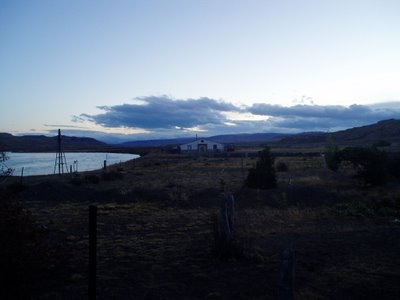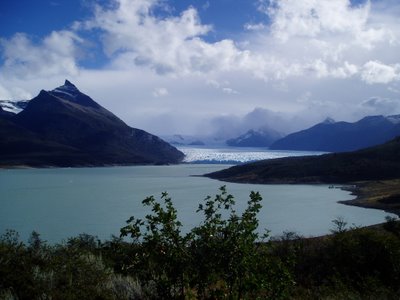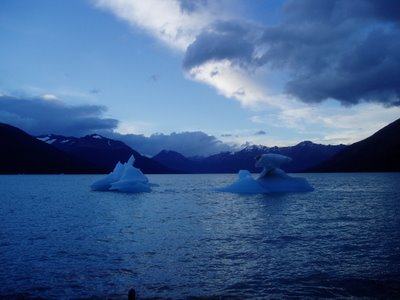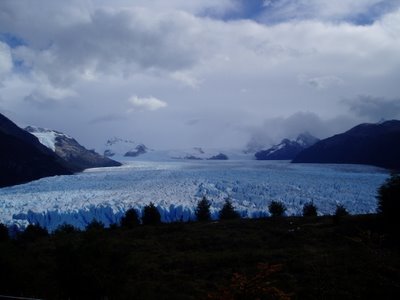Patagonia: El Chaltén & El Calafate
I left El Bolsón on yet another sunny and crisp afternoon, but by this time I was ready for the road and the long journey south. My destination - both in my mind and on my ticket - was Puerto San Júlian, a coastal town halfway down the country where I planned to catch another bus to El Chaltén, thus bypassing the standard and lengthy trip south to Río Gallegos, which is right in the corner of the continent. My Rough Guide called Puerto San Júlian "a convenient place to break the enormous journey between Trewlew and Río Gallegos", which is true, but I should have paid more attention to their other descriptions, including "treeless and barren to look at." Indeed. What's more, upon entering the bus station I saw that all of the bus service's kiosks were closed, which suggested that I may not find my connection to El Chaltén any time soon, if at all. The idling bus - of which almost all of the passengers were going to Río Gallegos - presented an opportunity, and while the driver was doing his paperwork in the office, I casually hopped right back on the bus and took my old seat. My first experience as a stowaway.
I don't like scamming Argentine corporations (I'm such a foreigner), so I felt rather badly for my decision, but at least they made me sweat a little for it. The last stop before Río Gallegos is Luis Piedra Buena, which is an even smaller and more desolate town than Puerto San Júlian, but for some reason it's also where a considerable number of new passengers chose to embark. I watched as the empty seats were steadily occupied, packed my bag, and began to make plans for staying in Luis Piedra Buena if the bus proved to be sold out. I was ever so relieved when we finally pulled out, every seat on the bus but mine claimed by a legitimate passenger. Thank you bus company; sorry about that.
By the time I arrived in Río Gallegos I had spent 27 hours on the same bus with only a few brief stops, but I was still a ways from my destination, and booked my bus to El Chaltén for 9:30am the next morning. Río Gallegos was typical of many of the Atlantic coast towns that I saw in Patagonia: wide roads and dirt sidewalks; makeshift shacks adjacent to cement houses; very few multi-story buildings; fences around every property; stray dogs everywhere; many properties in a state of partial completion, with piles of wood and cement blocks scattered about; faded colours. The town didn't appear to be good for much more than arriving, sleeping, and leaving, and that's about all that I did.

The trip from Río Gallegos to El Chaltén was beautiful and rather desolate.
It was quite a time-consuming journey from Río Gallegos to El Chaltén, and once again I found myself arriving in an unfamiliar town at midnight. I won the race to the nearest hostel though, and scooped up one of the last beds. Traveling can be stressful when one arrives somewhere, late, with no clue where one is going to stay, but it certainly teaches one to appreciate as simple a comfort as a roof and a few blankets. The next morning, El Chaltén would turn out to be a scattered town, easily the most rustic of any that I had visited, but perfectly situated next to Parque Nacional de los Glaciers, where lived many hiking trails and the area's star attractions: Cerro Torre and Fitz Roy Mountains. On a clear day, the twin spires of Torre and Fitz Roy, purple and orange as the sunlight oozes down them, jutting into the pure blue sky like the throne of a God, are an awesome marvel. Or at least that's what we've been told, for anyone who was there over just the same three days as I caught no sight of them for the clouds. That's okay though; the hike to Cerro Piltriquitron taught me to value the challenge rather than the reward.
El Chaltén certainly has its own vibe; a town that exists for no purpose other than to serve the needs of hikers and climbers, it lacks Bariloche's polish, El Bolsón's hippy spirit, and El Calfate's touristy manicure. What's more, the clientele matched the town's spartan character: here the hikers cooked their meals at 8:00pm in the hostel kitchen, perhaps allowing themselves a beer or two, but soon after set off for bed, alarms primed for 4:45am so that they could watch the shadow peel off of Fitz Roy as the sun rises. I stuck with my usual schedule, and won this round, as the early-risers received no reward but were only drenched for their dedication.
I spent one day relaxing - recovering, perhaps, after all that travel time - in El Chaltén, and three days hiking. Devoid of a nightlife, El Chaltén instead rewarded introspection, and I was happy to walk alone for a few days after a very social two weeks in El Bolsón. Not to mention that I had my hiking legs well under me at this point, and was able to cover as much ground in as little time as anyone there, I'd guess. It's difficult to describe the hikes, and I'll leave it to my pictures to even attempt it, but I'll just add that the reaction that many have to the Parque Nacional de los Glaciers is respect: respect for Fitz Roy, which despite its middling elevation remained unconquered by the world's best climbers for decades; respect for the weather, which is capricious and sometimes fierce; respect for the land, which offers as many challenges as one is willing to take on. Patagonia is many things but it's never mild. Parque Nacional de los Glaciers is the closest that most of us tourists got to knowing the hostility of the land.
It was quite a time-consuming journey from Río Gallegos to El Chaltén, and once again I found myself arriving in an unfamiliar town at midnight. I won the race to the nearest hostel though, and scooped up one of the last beds. Traveling can be stressful when one arrives somewhere, late, with no clue where one is going to stay, but it certainly teaches one to appreciate as simple a comfort as a roof and a few blankets. The next morning, El Chaltén would turn out to be a scattered town, easily the most rustic of any that I had visited, but perfectly situated next to Parque Nacional de los Glaciers, where lived many hiking trails and the area's star attractions: Cerro Torre and Fitz Roy Mountains. On a clear day, the twin spires of Torre and Fitz Roy, purple and orange as the sunlight oozes down them, jutting into the pure blue sky like the throne of a God, are an awesome marvel. Or at least that's what we've been told, for anyone who was there over just the same three days as I caught no sight of them for the clouds. That's okay though; the hike to Cerro Piltriquitron taught me to value the challenge rather than the reward.
El Chaltén certainly has its own vibe; a town that exists for no purpose other than to serve the needs of hikers and climbers, it lacks Bariloche's polish, El Bolsón's hippy spirit, and El Calfate's touristy manicure. What's more, the clientele matched the town's spartan character: here the hikers cooked their meals at 8:00pm in the hostel kitchen, perhaps allowing themselves a beer or two, but soon after set off for bed, alarms primed for 4:45am so that they could watch the shadow peel off of Fitz Roy as the sun rises. I stuck with my usual schedule, and won this round, as the early-risers received no reward but were only drenched for their dedication.
I spent one day relaxing - recovering, perhaps, after all that travel time - in El Chaltén, and three days hiking. Devoid of a nightlife, El Chaltén instead rewarded introspection, and I was happy to walk alone for a few days after a very social two weeks in El Bolsón. Not to mention that I had my hiking legs well under me at this point, and was able to cover as much ground in as little time as anyone there, I'd guess. It's difficult to describe the hikes, and I'll leave it to my pictures to even attempt it, but I'll just add that the reaction that many have to the Parque Nacional de los Glaciers is respect: respect for Fitz Roy, which despite its middling elevation remained unconquered by the world's best climbers for decades; respect for the weather, which is capricious and sometimes fierce; respect for the land, which offers as many challenges as one is willing to take on. Patagonia is many things but it's never mild. Parque Nacional de los Glaciers is the closest that most of us tourists got to knowing the hostility of the land.

Looking back towards El Chaltén.

Sometimes the scenery reminds me of Canada; sometimes it looks quite foreign. This swamp gave me a B.C.-ish vibe.

There she is: the majestic Cerro Torre, between the two visible peaks, coyly reveals its grandeur.
The last stop on this leg of my trip was El Calafate, which like Bariloche, is a popular destination for vacationing porteños and tourists, and is thus very touristy. Lots of hotels and hostels, chocolate shops, pricey restaurants with large slabs of meat proudly displayed in the windows, and of course many opportunities to buy a postcard or t-shirt. Not the kind of place in which I wanted to spend too much time, but before I passed through on my way to Ushuaia, I had to stop in at one of Patagonia's most famous tourist destinations: the Perito Moreno Glacier.
The Perito Moreno Glacier is a massive - just massive - glacier, one of only three in Patagonia that isn't receding, that stretches right across to the opposite shore of Lago Argentino, forming a natural dam between the two sides of the bisected lake. As a result, the water level slowly begins to rise on the Brazo Rico side of the lake, and can reach a height disparity of 30m with the other side before smashing through the glacier wall, restoring balance. This cycle occurs once every four or five years, the last rupture taking place only a few days before I arrived. Not that there's any shortage of activity on an ordinary day: pieces of the glacial wall are frequently falling off, making for quite an amazing noise, and splash.
The trip to the glacier eats up the whole afternoon and much of the evening, as they leave you there for about four hours. I was reminded of the Simpons episode in which they parody King Kong, and Mr. Burns (playing Carl Denham) is asked about the program for his show:
Reporter: What kind of a show you got for us, Mr. Burns?
Mr. Burns: Well, the ape is going to stand around for three hours or so. Then we'll close with the ethnic comedy of Duggan and Dirschwitz.
Reporter: Sensational!
In my case, I showed up, stared at the glacier for three hours or so, and then went for a brief hike. Sounds a little boring, but the glacier is so compelling that I was glad that I had the amount of time that I did. One can walk around a little and see it from different views, but really, you're mostly just watching it. Hopefully the pictures give some sense of why it rewarded such attention.

Like a frozen avalanche released from the mountains.

I had a strong impulse to swim over, climb up, and just walk into the distance. It was just so . . . naturey.
 Two liberated pieces that had swam away to freedom but became unfortunately lodged in a shallow part of the lake, where they now pose for pictures.
Two liberated pieces that had swam away to freedom but became unfortunately lodged in a shallow part of the lake, where they now pose for pictures.So that was about it for me and El Calafate, though I still had a fair amount of time to kill, as my bus didn't leave for Río Gallegos until 4:00am. The timing was ridiculous, and there were numerous buses between El Calafate and Río Gallegos, but I had seen a sign advertising a $25 peso fare, $7 pesos less than what was standard. I tried to buy a ticket for a trip at a reasonable time, like 8:00pm or 10:00pm, but was told that those cost $32 pesos; the reduced price was only available for the 4:00am trip. Trying to give me the old bait 'n' switch, eh? Well we'll see about that. So I was leaving for Río Gallegos at 4:00am. The bus, which was surprisingly busy, would take me to Río Gallegos by 8:00am, where I would catch another bus shortly thereafter that would make the long trip to Ushuaia. Just a 16-hour jaunt down to the end of the South American continent, into Chile, across the Magellan Strait, back into Argentina, to Tierra del Fuego, to the end of the world.


2 Comments:
Photos are great, we are thinking of going in October, do you know if there is a bus from bariloche to el Chalten? if so how much would it cost ect.
Thanks!
L.
2:06 p.m.
Nice, still seeing action here. Getting from Bariloche to El Chaltén is one of the classic problems of travelling in Patagonia; it seems like you should be able to just go straight down, but it's much tougher than it looks.
The RN-40 (which runs along the Andes connecting the two areas) is rough and mostly unpaved. I've read (and heard) that there is public transit along it, but it's less like a traditional bus and more like a tour (no flexibility, nowhere to stay along the way, fixed times and places to stay), and it's expensive. Can't say for certain who offers it, or even if it's available in October, as I wasn't interested.
By far the more traditional way is to take a bus from Bariloche over to the RN-3 (along the Atlantic coast), take that road down all the way to Río Gallegos, and then head back in to El Calafate and El Chaltén from there. There's a bus from Puerto San Julián to El Chaltén directly, but that's the one I had to skip for its infrequency, and that was in March, not October.
Cost . . . I'm forgetting now, but $200 pesos or so, I'd guess, for the RN-3 route. Have a good one.
3:06 p.m.
Post a Comment
<< Home